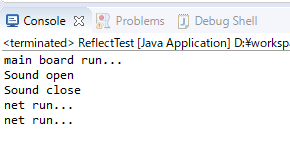需求:电脑主板,后期扩展具体扩展什么不清楚,但扩展必须具有打开和关闭的功能。
分析:有主板自己运行函数和扩展运行函数,扩展提供了规则,通过反射获取所有符合规则的类
主板代码
1 public class MainBoard { 2 public void run() { 3 System.out.println("main board run..."); 4 } 5 6 public void usePCI(PCI p) { 7 if(p!=null) { 8 p.open(); 9 p.close(); 10 } 11 } 12 }
扩展的规则接口
1 public interface PCI { 2 public void open(); 3 public void close(); 4 }
实现扩展的规则接口的实体
1 public class SoundCard implements PCI { 2 3 @Override 4 public void open() { 5 System.out.println("Sound open"); 6 } 7 8 @Override 9 public void close() { 10 System.out.println("Sound close"); 11 } 12 }
1 public class NetCard implements PCI { 2 3 @Override 4 public void open() { 5 System.out.println("net run..."); 6 } 7 8 @Override 9 public void close() { 10 System.out.println("net run..."); 11 } 12 }
增加其扩展性使用反射机制实现:通过配置文件实例化对象
配置文件(pci.properties)
pci1=cn.marw.reflect.test.SoundCard
pci2=cn.marw.reflect.test.NetCard
主程序实现代码
public static void main(String[] args) throws Exception { MainBoard mBoard=new MainBoard(); mBoard.run(); File configFile=new File("pci.properties"); Properties properties=new Properties(); FileInputStream fis=new FileInputStream(configFile); properties.load(fis); for(int x=0;x<properties.size();x++) { String picName=properties.getProperty("pci"+(x+1)); Class clazz=Class.forName(picName); PCI pci = (PCI) clazz.newInstance(); mBoard.usePCI(pci); } fis.close(); }
结果
